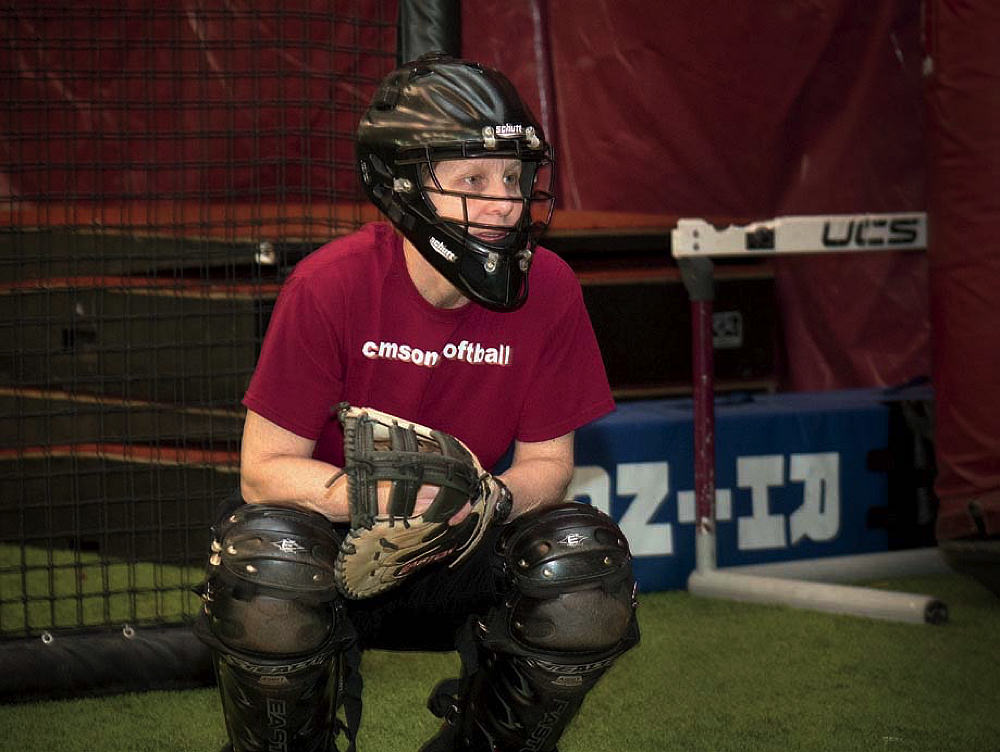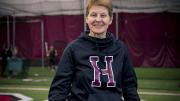Head softball coach Jenny Allard, who has led Harvard’s team for more than half of its existence and ranks among the Ivy League’s most successful coaches, doesn’t want this to be a story about her. “Write about the team,” she says. “Write about what Harvard softball has become, not just the titles but the culture, the bonds.” She gives a little wave of her hand. “Talk to the players—they’ve got good stories.”
And they do. Here are some of the stories the players tell:
Senior co-captain Maddy Kaplan, one of the team’s strongest hitters: “Coach Allard is a big reason why I came to Harvard.”
Former pitcher Rachel Brown ’12, Ed.M. ’16, who helped lead the team to back-to-back Ivy titles in 2011 and 2012: “It all begins with Coach—she’s created this community of women who want to be together; we make our best friends on the softball team, and those connections go on for years.”
Senior outfielder Alexa Altchek: “She knows how to pull greatness out of us.”
Junior co-captain Kaitlyn Schiffhauer: “Coach is the thread that connects all of us.”
A star pitcher and hitter for the University of Michigan in the late 1980s who threw her first softball when she was five years old, Jenny Allard arrived at Harvard in the fall of 1994, one of five coaches the University hired that year and the first full-time coach for softball. She was just 26, only three years into coaching (one as a part-timer at a high school in California, two as an assistant at Iowa), still exploring a profession—and a passion—that she’d turned to after a planned career in accounting left her cold. In those early seasons with the Crimson, she remembers, she and her players practiced in the indoor track, with its concrete floor and retractable tennis courts—or else in Lavietes late on a Friday night, after the basketball teams were gone. “We’d pull the nets away and get out this Astroturf that rolled the length of the court.”
The spring before she arrived, the team had gone 18-25 overall, and 4-6 in the Ivy League. Harvard had never won a conference championship. Allard set out to change that. “The freshmen I came in with, I didn’t recruit,” she says. “Those kids were all very talented, and I said, ‘You’re not graduating without an Ivy title.’” They didn’t. In Allard’s first season, Harvard finished second in the conference, with a 28-14 record overall, 9-3 Ivy. Three years later, in 1998, the team went unbeaten in Ivy play and brought home its first championship. Five others have followed, along with six 30-win seasons and five NCAA berths. Harvard softball is now a perennial postseason threat.

Allard works with her pitchers in the Harvard Stadium Bubble, softball and baseball’s winter practice site.
Photograph by Stu Rosner
That’s only half the story, though, Allard insists. The other half, harder to define, is wrapped up in the spontaneous road trips that seniors take together during the January term, or the fact that even on their day off from practice and each other, the players can usually be found together. Years after the women graduate, they travel by the dozens to attend each others’ weddings, or parents’ funerals. And it’s also in the fact that, for the third year in a row, Harvard earned one of the top 10 GPAs in the NCAA (3.588, the highest in the Ivies). That achievement began in the locker room, with a goal-setting challenge from Allard (who, with master’s degrees from the School of Education and the Extension School, spent 12 years as a freshman proctor and now is a non-resident adviser). It ended with the players pushing each other forward.
“We have a strong culture,” Allard says. Without it, the wins on the field don’t mean as much—and there are fewer of them. She figured this out during the 2006 season, a low point on the stats sheet, when the team went 20-24 and finished out of the top three in the league. There were illnesses and injuries and other issues, and for Allard, something shifted. “I’d learned a lot by then about how to coach the game, the strategy, putting players together, developing skills, all the technical pieces,” she says. “What I’ve really learned since is character and development, and the whole person.” A decade later, she says, “The players hand that down to each other.”
Not that her demands aren’t high, on and off the field. She expects hard work and good behavior, selflessness and supportiveness. “I tell my players, ‘My job isn’t to make your life easy; my job is to make your life better.’ So, knowing what you’re capable of doing and helping you get there.…There are times when I’ve got to push you, because I know you can get to another gear.”
This spring, the team expects to be in the Ivy title hunt again. For the first time in a few years, the roster is dominated by upperclassmen (only eight of 29 players are freshmen or sophomores), and seven returning players made All-Ivy honors last season. Among them is lefty hitter Rhianna Rich ’19, who finished second in the conference in 2017 with a .418 batting average and led the league with seven triples. Kaplan, the team’s number two hitter, got 11 extra-base hits last year, and center-fielder Schiffhauer surged late in the season, hitting .545 in the last eight games to help send the team to the Ivy championship series against Princeton, though the Crimson fell short of the title.
Ask these women for their favorite memory in a Harvard uniform, and the answer is unanimous: the final game against Dartmouth in 2016, which propelled the Crimson to the Ivy championship series. Harvard came into the seventh inning down one run, having dropped the first game of the afternoon’s doubleheader to the Big Green. “We were literally down to our last three outs for the season,” says Schiffhauer. The team got a base hit, and then another, and then Kaplan doubled to left field, sparking a rally that earned the Crimson four runs. Dartmouth couldn’t answer, and Harvard won 8-5. “That moment was such a team effort,” Kaplan says. “Everyone on the bench was screaming their heads off cheering, holding each other, and the energy was electric. Every girl who came up to bat was finding a way to get on base, finding a way to move the runners. That was the sweetest part. We all came alive together.”
And in the thrill and tension of that last inning, Allard stood on the third baseline, focused, grounded, “steering the ship,” Altchek says. “A rock.” Adds Schiffhauer: “There’s so much trust between us and Coach. You really see it in moments like that.”
That image is reminiscent of another that came to mind for Brown. In 2013, one of her teammates married a Harvard swimmer. Something like 35 softball players traveled to attend, from perhaps seven or eight graduating classes. And on the morning of the ceremony, they held a giant slow-pitch softball game, with the bride and groom and all their friends swirling around the field. Reprising her playing-days position, Allard stepped in as the designated pitcher. “And to see Coach in the middle of all this,” Brown says, “and to think, this is something she created. She created this community of women who will be with each other through life.” In that way, they never leave the field.







